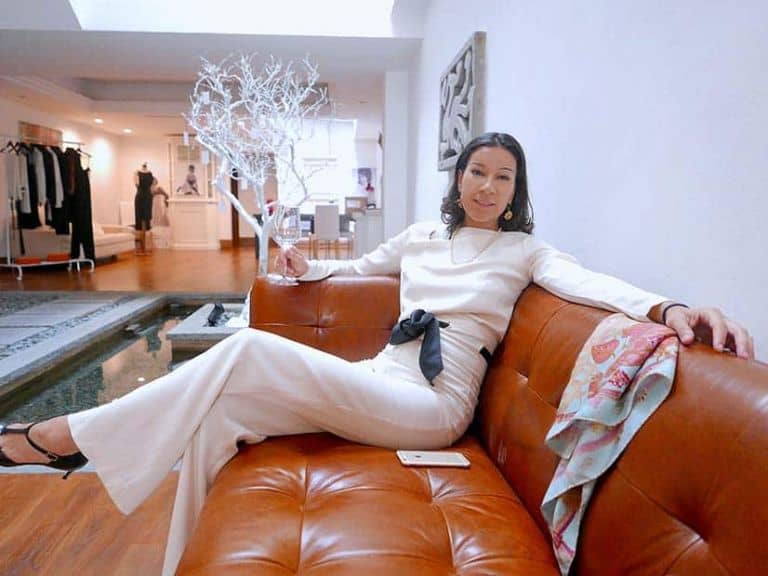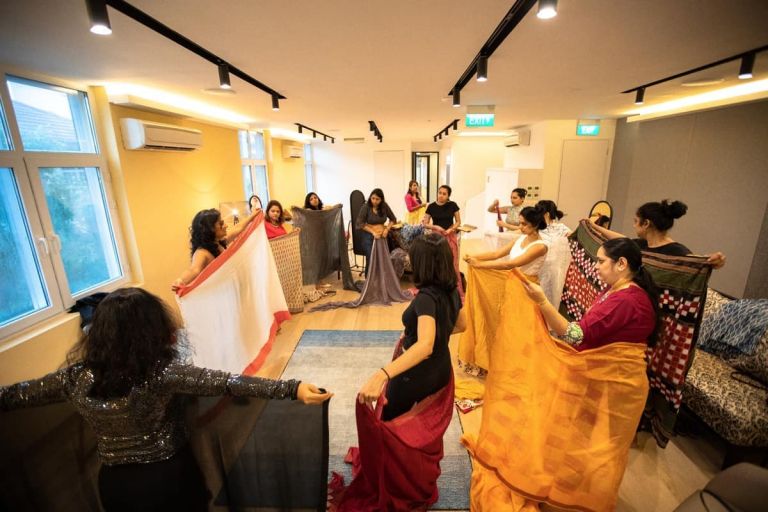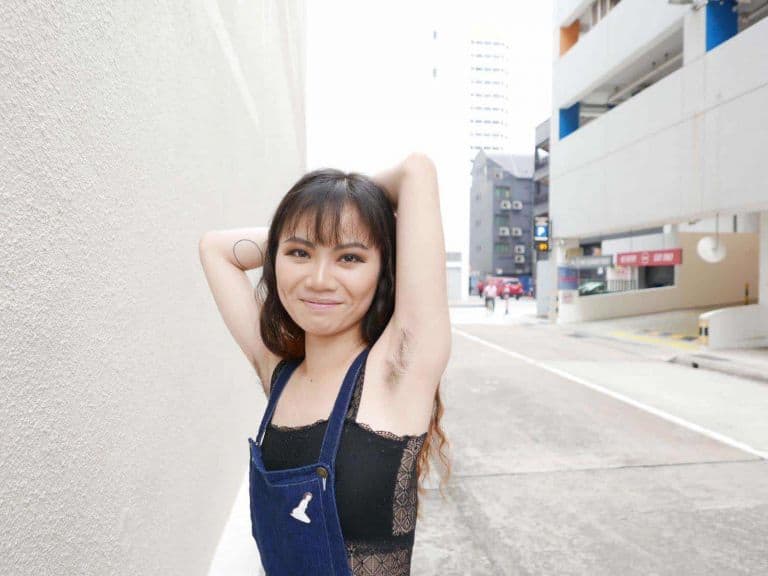In this final installment of our collaboration with Gillian Daniel, the talented creator behind @fashofthetitans, an Instagram account that pairs famous artworks with runway looks, she delves into the art of Jolly Koh, Gregorius Sidharta Soegijo, Shi Xiangtuo and Earl Lu.
1. Blumarine Fall 2017 vs Backstage (1959) by Jolly Koh
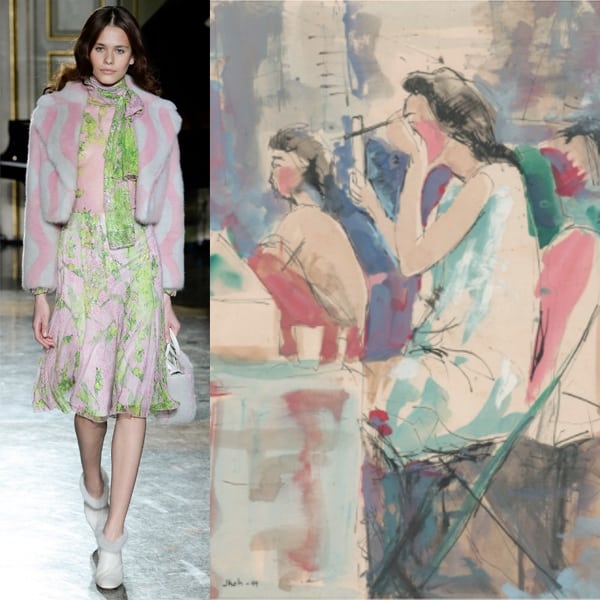
Before I came across this early work by Jolly Koh, I had only seen his colourful abstract oil and acrylic paintings. When I stumbled upon this watercolour and ink work, I was drawn to its scene of a woman carefully drawing her eyebrows in the mirror. The title alludes to the fact that she might be a performer, perhaps a singer or dancer, backstage getting ready for showtime.
There is something intimate about the painting, perhaps in the way it is framed to show a woman against a busy backstage scene, engaged in the small but meaningful gesture of putting on her makeup — a quiet, private moment as she readies herself to take up a very visible position on the stage. At the same time, there is a quality of an old-world glamour about this woman, in the dressing room with her perfectly coiffed black hair and diaphanous mint dress.
This model in Blumarine looks to me like she could have stepped right out of Koh’s painting. It is the combination of the pastel pinks and greens, with her cascading, perfectly styled dark locks. I like to imagine that she is Koh’s protagonist, after the curtain comes down on yet another successful performance. Maybe she’s on tour somewhere cold with her troupe. She throws on her warm faux-fur coat, carefully selected to match her costume, and heads out the stage door into the night.
(Artwork details: Jolly Koh Backstage, 1959. Watercolour and ink on paper. Image measurement: 37 x 26cm. Gift of the Loke Wan Tho Collection. Collection of National Gallery Singapore.)
2. Alexander Wang Spring 2019 vs Lengkung Dinamika (Dynamic Curve) (1971) by Gregorius Sidharta Soegijo
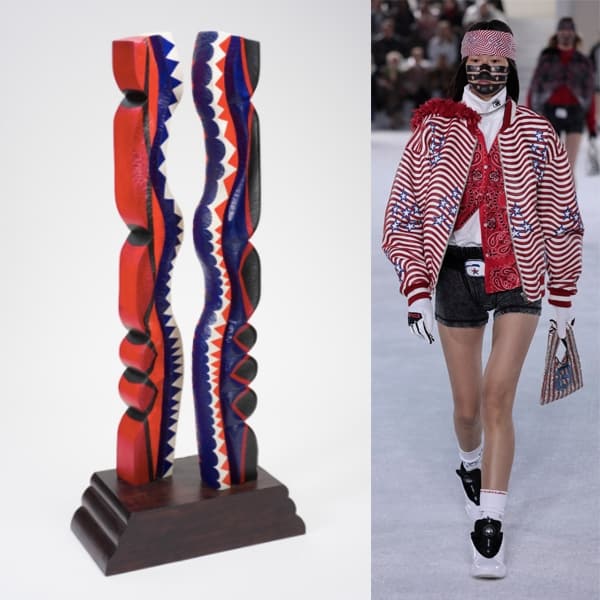
This striking sculpture by the Indonesian sculptor Gregorius Sidharta Soegijo comprises two painted totem-like forms of mahogany wood. Standing at 170cm tall, the riotously coloured and patterned columnar forms almost appear to be in confrontation with one another. At the time that it was created, Sidharta was criticised for his treatment of sculpture, which tended toward more naturalistic forms.
Of course, Sidharta’s sculpture and this Alexander Wang look share a similar colour palette of black, red, and blue. But to me, the quality that unites them is their spirit of dynamism and rebellion, expressed through a chaotic clash of colours and patterns. The wavy lines on the Alexander Wang jacket and the Sidharta’s curves create a sense of tumultuous movement. The jagged lines on the sculpture and on the stars of the jacket add just the right dash of verve.
(Artwork details: Gregorius Sidharta Soegijo, Lenkuang Dinamika (Dynamic Curve), 1971. Painted mahogany wood. Image measurement: 120 x 45 x 35 cm. Collection of National Gallery Singapore.)
3. Marni Spring 2015 vs Hong Kong Bauhinia and Grackle (1977) by Shi Xiangtuo
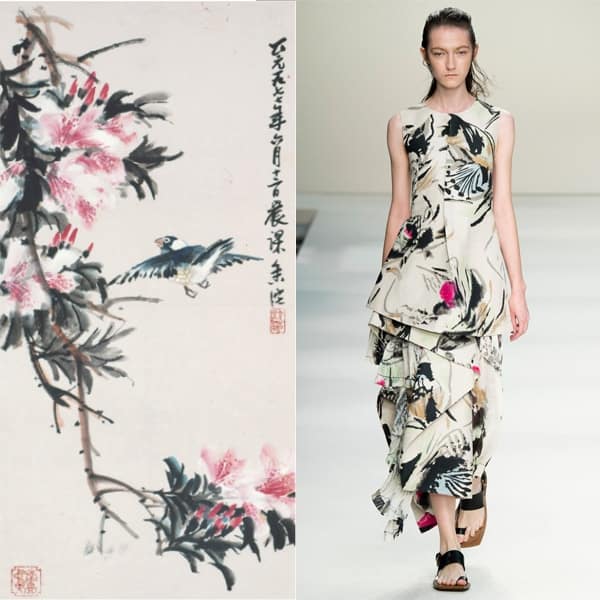
Born in Fujian in 1906, Shi Xiangtuo (a.k.a. See Hiang To) came from an eminent lineage of calligraphers and seal-carvers. Shi arrived in Singapore in 1938 and became involved in many key art societies of his time, including the Society of Chinese Artists, which he would serve two terms as President for. He also contributed actively to art education, eventually becoming a lecturer at the Nanyang Academy of Fine Arts. An avid nature lover, Shi would bring his students on plein air painting trips to observe the local flora and fauna. Many of these would eventually become motifs in his artwork.
So many elements of this particular work by Shi are visible in this Marni dress. The painterly print on the dress recalls Shi’s expressive evocation of a bird floating above a laden branch of the bauhinia plant, extending from a corner of the picture plane toward the viewer and bursting with vibrant blooms. The tiered skirt of stiff layers also evokes sheets of paper. But my favourite detail is how the inky blue feathers of the grackle’s wings are just visible in the section of the print under the bustline on the Marni dress upon closer scrutiny.
(Artwork details: Shi Xiangtuo (a.k.a. See Hiang To), Hong Kong Bauhinia and Grackle , 1977. Chinese ink and colour on paper. Image measurement: 59.2 x 29.3 cm. Collection of National Gallery Singapore.)
4. Dries Van Noten Spring 2020 vs Roses (undated) by Earl Lu Ming Teck
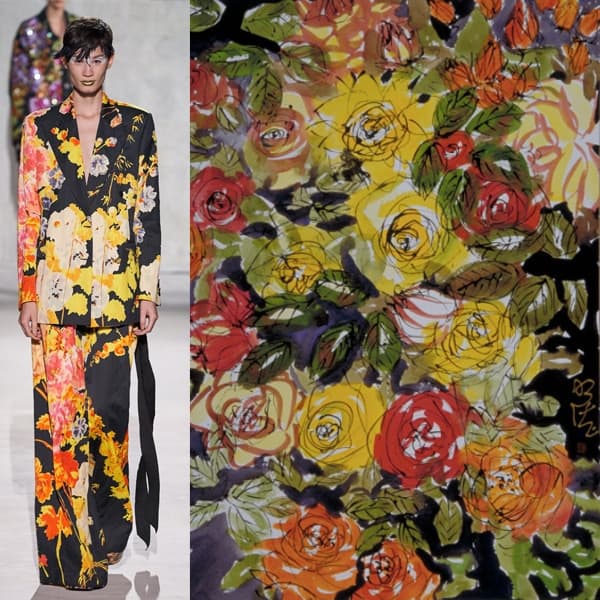
When I make my matches, I often start with the fashion. I studied art history and work in a museum, so I have a far bigger visual bank for art than I do fashion. @fashofthetitans started with me combing through runway collections to see which looks reminded me of artworks I know and like. But after six years, I’ve gradually become more familiar with the styles of different fashion houses too. I am now more able to start from artworks and challenge myself to find their fashion doppelgängers.
When I was doing the research for this article, I came across this ink work by Earl Lu Ming Teck. I was struck by the way it is atypical of a Chinese ink painting. I like how it blends the techniques of Western painting with Chinese traditional painting. It includes the Western technique of manipulating light and shadow to evoke three-dimensional form and forgoes a play with negative space. Yet, it retains the linework of Chinese painting.
There is something about the visual qualities of Lu’s work that makes it look like a digital print on fabric. I imagined that I would find a print like this somewhere in one of Dries Van Noten’s Spring collections, with Lu’s work translated to a sumptuous floral print on buttery silk. All it took was a dive into a few spring collections and there it was!
(Artwork details: Earl Lu Ming Teck, Roses, undated. Chinese ink and colour on paper. Image measurement: 76.3 x 56.4cm. Collection of National Gallery Singapore.)
______________________________
If you enjoyed this article, you’ll love our previous two stories featuring @fashofthetitans too. Check them out here and here!







